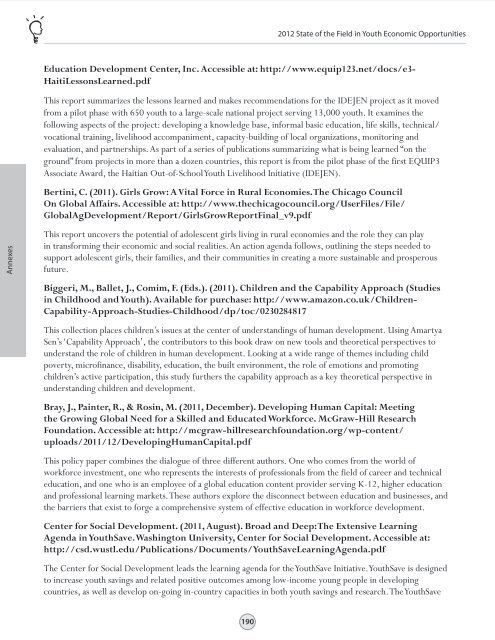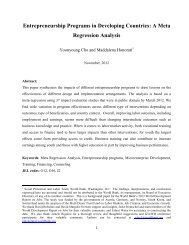STATE OF THE FIELD IN YOUTH ECONOMIC OPPORTUNITIES
STATE OF THE FIELD IN YOUTH ECONOMIC OPPORTUNITIES
STATE OF THE FIELD IN YOUTH ECONOMIC OPPORTUNITIES
You also want an ePaper? Increase the reach of your titles
YUMPU automatically turns print PDFs into web optimized ePapers that Google loves.
Table of Contents<br />
Chapter 1 Chapter 2 Chapter 3 Chapter 4 Chapter 5 Chapter 6 Chapter 7 Chapter 8<br />
Chapter 9<br />
Chapter 10 Chapter 11 Chapter 12 Chapter 13 Chapter 14 Chapter 15 Annexes<br />
2012 State of the Field in Youth Economic Opportunities<br />
Education Development Center, Inc. Accessible at: http://www.equip123.net/docs/e3-<br />
HaitiLessonsLearned.pdf<br />
This report summarizes the lessons learned and makes recommendations for the IDEJEN project as it moved<br />
from a pilot phase with 650 youth to a large-scale national project serving 13,000 youth. It examines the<br />
following aspects of the project: developing a knowledge base, informal basic education, life skills, technical/<br />
vocational training, livelihood accompaniment, capacity-building of local organizations, monitoring and<br />
evaluation, and partnerships. As part of a series of publications summarizing what is being learned “on the<br />
ground” from projects in more than a dozen countries, this report is from the pilot phase of the first EQUIP3<br />
Associate Award, the Haitian Out-of-School Youth Livelihood Initiative (IDEJEN).<br />
Bertini, C. (2011). Girls Grow: A Vital Force in Rural Economies. The Chicago Council<br />
On Global Affairs. Accessible at: http://www.thechicagocouncil.org/UserFiles/File/<br />
GlobalAgDevelopment/Report/GirlsGrowReportFinal_v9.pdf<br />
Annexes<br />
This report uncovers the potential of adolescent girls living in rural economies and the role they can play<br />
in transforming their economic and social realities. An action agenda follows, outlining the steps needed to<br />
support adolescent girls, their families, and their communities in creating a more sustainable and prosperous<br />
future.<br />
Biggeri, M., Ballet, J., Comim, F. (Eds.). (2011). Children and the Capability Approach (Studies<br />
in Childhood and Youth). Available for purchase: http://www.amazon.co.uk/Children-<br />
Capability-Approach-Studies-Childhood/dp/toc/0230284817<br />
This collection places children’s issues at the center of understandings of human development. Using Amartya<br />
Sen’s ‘Capability Approach’, the contributors to this book draw on new tools and theoretical perspectives to<br />
understand the role of children in human development. Looking at a wide range of themes including child<br />
poverty, microfinance, disability, education, the built environment, the role of emotions and promoting<br />
children’s active participation, this study furthers the capability approach as a key theoretical perspective in<br />
understanding children and development.<br />
Bray, J., Painter, R., & Rosin, M. (2011, December). Developing Human Capital: Meeting<br />
the Growing Global Need for a Skilled and Educated Workforce. McGraw-Hill Research<br />
Foundation. Accessible at: http://mcgraw-hillresearchfoundation.org/wp-content/<br />
uploads/2011/12/DevelopingHumanCapital.pdf<br />
This policy paper combines the dialogue of three different authors. One who comes from the world of<br />
workforce investment, one who represents the interests of professionals from the field of career and technical<br />
education, and one who is an employee of a global education content provider serving K-12, higher education<br />
and professional learning markets. These authors explore the disconnect between education and businesses, and<br />
the barriers that exist to forge a comprehensive system of effective education in workforce development.<br />
Center for Social Development. (2011, August). Broad and Deep: The Extensive Learning<br />
Agenda in YouthSave. Washington University, Center for Social Development. Accessible at:<br />
http://csd.wustl.edu/Publications/Documents/YouthSaveLearningAgenda.pdf<br />
The Center for Social Development leads the learning agenda for the YouthSave Initiative. YouthSave is designed<br />
to increase youth savings and related positive outcomes among low-income young people in developing<br />
countries, as well as develop on-going in-country capacities in both youth savings and research. The YouthSave<br />
190

















